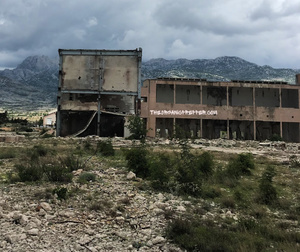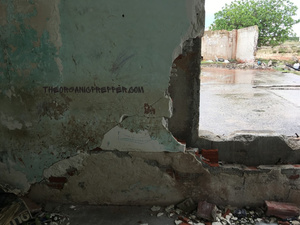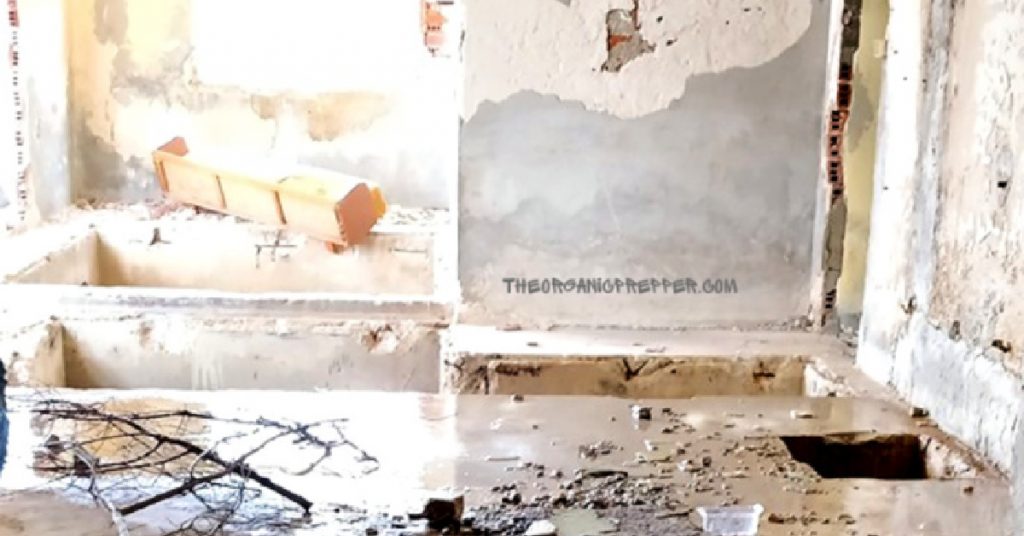If you're new here, you may want to subscribe to my RSS feed. Thanks for visiting!
Author of Be Ready for Anything and Bloom Where You’re Planted online course
What happens when you take a chubby, middle-aged mom, put her on a creepy, abandoned military base and tell her to clear a building in which to take shelter?
Since it’s not a real SHTF scenario, hilarity ensues. But had this been an actual emergency, (read that in the voice of the guy who does the National Broadcast System on television) it wouldn’t have been one bit funny. It would have been deadly and now I understand far better how so many people died quickly when Bosnia descended into mayhem.
Let’s go back to the beginning and I’ll tell you about how I survived Selco’s first Urban Survival Course for Women.
The course
At first, I wasn’t nervous at all. I felt fairly confident in my skills, although physically, I wasn’t in the greatest shape. I recently had major abdominal surgery and after an awesome few weeks in the Balkans, I had a little tickle in my throat. But I figured I’d be fine.
Well, that was the first mistake of numerous ones I’d make during the five-day course.
But one thing that was not a mistake was getting off my butt and flying halfway across the world to undertake this training. I met 5 extremely cool, bad-ass women who joined me in Croatia where we learned important lessons, drank a significant amount of wine, and saw some incredibly dark things.
Part of the course was educational (sort of a classroom setting) and the other part was experiential (actually going out into the field). Also, I never thought I’d text someone “In the field. Can’t talk.” But, hey, now I have.
The course had 2 instructors to 6 of us ladies. Of course, the Big Kahuna was Selco, who is a really cool guy. Next, there was Toby Cowern, the owner of Tread Lightly Survival. Toby is a former member of the British Royal Marines, a British military intelligence guy, and a wilderness survival instructor. Between these guys, there is a huge amount of real-world experience and they were enthusiastic to pass on their knowledge.
The classroom stuff was incredibly interesting. Generally, I have trouble sitting and listening to someone talk but the guys were funny, engaging, and vastly informative. Not once did I feel like I was nodding off. I have at least 30 pages of notes that were all “aha” moments.
However, by Day 2, my tickle in the throat had turned into a full-blown cold with a deep bronchial cough. Nothing like adding a little reality to my doomsday scenario, right? I stuck with it – and ladies, if you ended up with a cold when you got home, I’m really sorry. Just call me Typhoid Daisy.
Being in the field
Remember how I said we visited some pretty sketchy places?
Well.

You can’t prepare online for the smell of decay or the uneasy feeling of hazards everywhere.
The buildings told a story of a time past when shelling and sniper fire occurred nearly constantly. They also told a more modern story about people using these feces-filled, dangerous, filthy buildings as a stopover.
We visited numerous buildings with the guys to escort us and each one told a multitude of stories about the people unfortunate enough to have spent time there.
But that wasn’t all – it wasn’t just about other people’s memories. There were innumerable dangers – everything from unexpected person-sized holes in the floor to shattered glass to drug paraphernalia. There was debris from the past 30 years everywhere, rusting and rotting. The chances of getting hurt seemed fairly high, but the course was run extremely well and we had no casualties.
These abandoned buildings were our playgrounds and classrooms over the five days we spent together.
Exercises
At night, we slept in large, pleasant apartments with central heat and air, hot water in the shower, and a fridge to keep our drinks cold.
During the daytime, it was a completely different matter. Survival isn’t a comfortable thing and we certainly were not made comfortable during the day. (I even peed outside – it’s not my thing – and survived to tell you this tale.)
The temperatures fluctuated from hot sunburn weather to cold and rainy. Bad weather did not halt our activity and it absolutely delighted 
After a couple of days to orient us, we were turned loose in the field. We were given assignments. “Pretend you’re in X situation and go out there and do what you would do if that was actually happening right now.”
We did recon to locate suitable shelters. We set up temporary camps, built fires, boiled water, and ate meals in some pretty grim circumstances. We cleared buildings. We used our tools and gear and really put things to the test.
Night exercises
Day 4 of the course was particularly long. We started at 8:30 in the morning and were out until 11:00 at night. Part of the day was spent in the “classroom” – a kitchen table – but the majority was out in the field.
This was the day we learned to be stealthy – or we tried. I like to think my coughing-up-a-lung provided cover noise for my teammates. We were taught to cross the glass and debris-littered surfaces barely making a sound, something I’ve been practicing since I got home. (Look out, pets and family!)
Later in the day, we drove out to a former factory that had been turned into a military base during the war. This was where we spent most of the day (and where I finally peed outside.)
After a few hours completing our tasks, we drove to another abandoned base where we had to stealthily (I’m really not very stealthy yet) clear a building and take cover. It was rigged with harmless yet realistic booby traps and by this time, it was getting dark. Stealth is slow business – it can take an hour to cross 40 feet.
Then, of course, it began to rain. Torrentially.
My water-resistant jacket kept the worst of it off me but I passed my hat off to a teammate who was wearing glasses
Then I tried to kneel and I’m sorry but I have to admit, my knees snapped, crackled, and popped and I found myself stuck in that position until I finally rolled onto the ground and pushed myself up on all fours. Like a bug stuck on its back. Really stealthy, right? But, as our fearless leaders repeatedly reminded us, you have to train for the body you’re in. And by this time, my body was feeling the effects of a long day, being cold and wet, recuperating from surgery, and having a terrible cold.
By around 10 o’clock we’d all conquered the building in some way and there was an offer to stay overnight. I’m going to be really honest here: not for all the tea in China did I want to sleep there and especially not with my increasingly horrible cough and cold.
It was wet, chilly, and downright uncomfortable by the end of the exercise and I was delighted to get back to the apartment and hit a hot shower.
I’ve got a long way to go.
A lot of what I learned in this course is that in many areas, I have a long way to go and most of that is physical. I think my Balkan boot camp (trying to keep up with Selco’s long legs) has me off to a good start. But before I started actually doing these things that I’ve described above, I didn’t realize what a liability I would be in certain situations. Now, I have a plan to work on this stuff and improve because I know.
It’s important to remember that prepping and survival are two different things. Just because you have enough food to see your family through 4 years of pestilence doesn’t mean you’d do okay if you were stranded in an urban environment when the SHTF in a big and violent way. Both of these things are very good things to do, but you need to do both. Just one won’t do it if things really go south.
I guess the biggest question I have for you is whether you also have a long way to go. And take it from me, you won’t know until you test it in the closest environment possible.

















I’m so glad you took this. Maybe I won’t seem like such a harsh hardcore meanie now on some things.
I’m not trying to be but it’s tough, beyond tough cause one oops and your toast. I shoulda been a few times myself.
I learned more in 6 months there than I did the prior 4-5 years that helped me stay alive the rest of my careers.
Selco and the rest of us just want what’s best for folks. Despite going thru all those things he kept that. I’m not sure I would have. I got to go home and it still effected me.
I can’t wait to read the rest.
Fascinating Daisy!
You are the bada$$ in my world and (I am jealous!).
I know you are so right when you say nothing compares to actually doing it. Thanks for your bravery! Just traveling overseas is a feat in itself these days and surviving all of that with a cold. Omg…
He!! Yeah I’m impressed.
My husband and I read Selco’s book. And I thought about you everyday while you were there. Imagining the scenarios we read and inserting ourselves into it.
Thanks for all you do Daisy!
WOW! Wow
Daisy, in one of your previous articles you mentioned that Selco made the statement, you don’t go across the street without your level 1 equipment. I am very curious about what he considers level 1 equipment.
I’ll ask him to write about that – it would be a great article. Short version – it’s the stuff essential to survival for you personally to get you by for 24 hours. So my layer one, for example, is: lighter, Israeli bandage, knife, bandana, (for a tourniquet, mouth cover, or water filter), peanut M&Ms, hand sanitizer, and water purification pills. In the US, it’s also a gun. For another person, an important addition might be an epi pen or nitro pills. Layer 2 is the stuff that you could survive without but probably would much rather have, and Layer 3 is more about comfort.
So glad to hear about your course! Looking forward to future posts about it too.
You can read about things, watch YouTub vids, watch Doomersday prepper people (I dunno, I heard about it, never seen it, gave up TV back in ’08), but nothing beats going to the FIELD!
“If it ain’t raining, we ain’t training!”
Good for you Daisy! Gotta get out of your comfort zone and get dirty.
I absolutely hated that cliche! Especially when I was in the field getting ready for an assault in a freaking downpour and 50 MPH winds…oh and the cold! (and I walked 10 miles in the snow to school uphill both ways)
As I have gotten older I appreciate all of those miserable days; hence why I still know how to prepare “for the field.” Lots more “snivel” gear.
WOW. This sounds incredible and I can’t wait for the follow up piece! I would love to do this someday. Probably not the very next course, but one of them. It sounds incredibly educational.
Awesome Lady, awesome, lady.
You self depreciate to much Daisy, doing this kind of thing while sick and recovering from surgery is hardcore.
Daisy
Nice to read you marked your territory in Croatia.
Look forward to future articles.
Thanks
ps.
While not even close to your experience while Bosna was occuring back then, I was part of a team for the renovation of a multiple building abandoned school.
One part of the job I was volunteered for was wake to up and announce our presence to the homeless squatters so there wouldn’t be any surprises. It began by beating on each building’s front entrance with a baseball bat. An anti-stealth device.
After a day or so you could tell the different smells in the dark rain soaked corridors. Human feces is different from rat urine from the various cockaroach poop trails.
Tunnels. If anyone is anticipating close quarters urban fighting expect a maze of tunnels, from below basement level to within walls. Wall thicknesses vary from four inches to six or more feet of utility vertical runways. In videos of Sarajevo there were holes broken thru walls for long corridors. Bring a crow-bar and heavy duty hammer in the SHTF. Note, European walls may not be solid concrete or light weight 2×4 construction as much as waffled tiles, brick, plastered on both sides for strenght. So learn your local building contruction and utility routes.
Bedding. Where someone was sleeping the night before there usually was a handmade weapon, improvised knife or club. And broken glass on the floor either to warn of another approaching homeless person or to cut the paws of the dogs the city would occasionily send in to drive out the residents. There was drug paraphernalia scattered around. I guess acquiring AIDS from used needles was a perk of the job.
Anyway, look forward to more articles on your experiences with Selco’s and Toby’s Trend Lightly School.
Join your states militia. We give that training for free. Plus you have plenty of backup if sdhtf
Sorry, since I’m yapping away I’ll throw out a concept I consider as a training exercise any couch potatoe can do.
You Tube has videos of people walking around a city with a Go Pro camera or similiar equipment, in one continuous flow. ‘Actionkid105’ is one example. His convoluted walks through New York’s West Village are good.
Initally watch the video. Then afterwards write down what you watched. What was the names of the streets traveled? How many blocks and turns, what direction? Etc.
Usually I’m distracted by the pedestrians to look for street signs and have to make an effort to be aware of where the video is at.
Then watch the video again and again. Print out a map of the route traveled. Goggle map has a symbol of a little guy you can move onto the street map to get a road view from the van that recorded the area. Compare that to what to you remember from the video. Go back and forth, or travel visually down an unfamiliar street. This is also good if you’ll be driving for a trip to a new city and need to know where the turn lanes are.
While definitely not the real experience, you begin to pick up on the ambient things like where the sun is to get a general idea the direction you’re going, down to noticing people thirty or so feet away. Are they approaching you or are they in groups. A lot of urban assaults happen before you’re even aware they’re there.
Now imagine no signs, no lights. I onced got lost in a Moroccan marketplace totally disorientated. Nothing familiar, no cues that I would’ve be familiar with in a home city. I was very glad to find my way out before it got dark or walked down the wrong ally. I call it “Culture Shock”.
This mental exercise isn’t the real experience of course but every little thing helps.
Good Job! Like 1st Mar Jarhead said… ‘If it anit raining, it aint training’ (24 years Army, 15 of it Airborne, and I got the bad knees to prove it…lol)
As far as the cough goes… I’ve flown all around the states and the world and I learned a long time ago to load up on vitamins and herbals starting a week before flying, continue while in country (if possible) and then more so for the week after arriving back home, and that includes Airborne gummies, multi-vitamins, Echinacea and Zinc and of course, hand sanitizer. (this includes stateside air travel too. Airports are nothing but international petrie dish’s… and no I’m not a germ-a-phoebe, just germ aware.)
Ask any Soldier/Marine, and every one of them will tell you at least one time when they were in the field, sick as a dog with quadruple pneumonia while it was 39 degrees and raining and they thought they were ‘gonna die’. Life sucks but you usually survive…
But again Daisy… Good Job!
Oh, and one more miner item… not in my EDC but in my ruck, I always have a zip-lock with about 10 throat lozenges in it for that sore or tickle throat, and they have almost no expiration date, (they really do, but who cares when your throat hurts…)
sorry… minor, not miner
I am just so impressed by what you did! Everybody is an armchair expert, but then to put all of your training and preperations to the test is awesome! I can bet that this experience changed a lot of what you will think of doing and what actions you will take in the future. Being an LA girl, I can honestly say that earthquakes can be planned for, but nothing gets you “ready” like the real life action of one. It’s one of the reasons that I moved to Sierra terra firma. I can’t wait to read more of your thoughts and hear about the differences of before and after Selco!
You are awesome Daisy! ????????????
Impressive and badass!
As an aside, you probably got sick here in the US. Your upper respiratory infection sounds like the one that I had last month. That went into an ear infection for me, and even after a course of antibiotics the cough is still lingering although not as bad.
Kudos to you for getting through the course while sick AND recovering from surgery!
Interested in obtaining dehydrated food meals. Has anybody tested such ?? Have recomdations for nutrition, taste, longevity, durability, etc. Thanks !